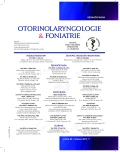Microbial Colonization of Upper Respiratory Pathways and Immunity in Children with Adenoid Vegetation
Authors:
G. Bugová 1; B. Uhliarová 2; M. Jeseňák 3; A. Hajtman 1
Authors‘ workplace:
Klinika ORL a ChHaK UK JLF a UNM v Martine
1; ORL odd., FNsP FD Roosevelta, Banská Bystrica
2; Klinika detí a dorastu UK JLF a UNM v Martine
3
Published in:
Otorinolaryngol Foniatr, 66, 2017, No. 1, pp. 16-21.
Category:
Original Article
Overview
Introduction:
The upper aerodigestive tract is the most common point of entry for pathogens and serves as a first step in interaction between microorganisms and immune system. Many disorders of immune system are manifested as infection of upper aerodigestive tract. On the other hand, those infections are also common in patients with an intact immunity, especially among children.
Methods:
The prospective study was conducted with 61 children that were scheduled to endoscopic adenotomy for adenoid vegetation at the Department of Otorhinolaryngology, Head and Neck Surgery, Comenius University, Jessenius Faculty of Medicine, University Hospital in Martin, Slovakia. Relationship between microbiological findings in middle meatus and nasopharynx, presence of atopy, as well humoral and cellular components of immunity were evaluated.
Results:
Pathogenic bacteria were isolated in 58 % samples from middle nasal meatus and 72 % samples from nasopharynx. Streptococcus pneumoniae, Staphylococcus aureus, Haemophillus influenzae and Moraxella catarrhalis were the most common identified pathogens in both middle nasal metaus and nasopharynx. Identification of pathogenic bacteria in middle nasal meatus did not correlate with isolation of pathogenic bacteria in nasopharynx. Atopy was diagnosed in 83 % children with adenoid hypertrophy. Presence of atopy was associated with significantly decreased presence of saprophytes and more often colonization of pathogenic bacteria in the middle nasal meatus (P=0.37, P=0.45, respectively). Severe impairment of immunity was not detected.
Conclusion:
Identification of pathogenic bacteria in middle nasal meatus does not correlate with isolation of pathogenic bacteria in nasopharynx. Targeted antibiotic treatment should be chosen by a result from nasopharyngeal swab and not from the nasal cavity. Atopy is an important factor in the pathogenesis of adenoid vegetation. Therefore, immunoallergologic examination should be a standard part of the management and diagnostic procedures in children with adenoid vegetations. Children with recurrent respiratory infections are rarely caused by inborn defects of immunity.
KEYWORDS:
pathogens, upper airways, immunity, atopy, adenoid vegetatios
Sources
1 Baradaranfar, M. H., Dodangeh, F., Taghipour-Zahir, S. et al.: Humoral and cellular imunity parameters in children before and after adenotonsillectomy. Acta Med. Iran, 45, 2007, 5, s. 345-350.
2. Barreto, M., Villa, M. P., Monti, F. et al.: Additive effect of eosinophilia and atopy in exhaled nitric oxide levels in children with or without a history of respiratory symptoms. Pediat. Allergy Immunol., 16, 2005, 1, s. 52-58.
3. Brndiarová, M., Mikler, J., Bánovčin, P. et al.: Extraeozofágový reflux – otolaryngologické komplikácie gastroezofágového refluxu. Čes-slov. Pediat, 66, 2011, 2, s. 85-91.
4 Brook, I., Shah, K.: Bacteriology of adenoids and tonsils in children with recurrent adenotonsillitis. Ann. Otol. Rhinol. Laryngol., 110, 2001, 9, s. 844-848.
5. Fergie, N., Bayston, R., Pearson, J. P. et al.: Is otitis media with effusion a biofilm infection? Clin. Otolaryngol., 29, 2004, s. 38-46.
6. Greenberg, D., Givon-Lavi, N., Broides, A. et al.: The contribution of smoking and exposure to tobacco smoke to Streptococcus pneumoniae and Haemophilus influenzae Carriage in children and their mothers. Clin. Infect. Dis., 42, 2006, s. 897–903.
7. Ikinciogullari, A., Dogu, F., Ikinciogullari, A. et al.: Is immune system influenced by adenotonsillectomy in children? Int. J. Pediatr. Otorhinolaryngol., 66, 2002, s. 251-257.
8. Jeseňák, M., Rennerová, Z., Bánovčin, P. et al.: Recidivujúce infekcie dýchacích ciest a imunomodulácia u detí. Praha, Mladá Fronta, 1. vydanie, 2012; s. 632.
9. Marseglia, G. L., Caimmi, D., Pagella, F. et al.: Adenoids during childhood: the facts. Int. J. Immunopathol. Pharmacol., 24, 2011, 4, s. 1-5.
10. Marzouk, H., Aynehchi, B., Thakkar, P. et al.: The utility of nasopharyngeal culture in the management of chronic adenoiditis. Int. J. Pediatr. Otorhinolaryngol., 76, 2012, 10, s. 1413-1415.
11. Post, J. C, Stoodley, P., Hall-Stoodley, L. et al.: The role of biofilms in otolaryngologic infections. Curr. Opin. Otolaryngol. Head Neck Surg, 12, 2004, s. 185-190.
12. Stoodley, H. L., Costerton, J. W., Stoodley, P.: Bacterial biofilms: from the natural environment to infectious disease. Nat. Rev. Microbiol., 2, 2004, s. 1-15.
13. Šemberová, J., Rychlý, B., Hanzelová, J. et al.: The immune status in situ of recurrent tonsillitis and idiopathic tonsillar hypertrophy. Bratisl. Lek. Listy, 114, 2013, s. 140-144.
14. Wang, E. W., Jung, J. Y., Pashia, M. E. et al.: Otopathogenic pseudomonas aeruginosa strains as complent biofilm formers. Arch. Otol. Head Neck Surg., 131, 2005, s. 983-989.
15. Zautner, A. E.: Adenotonsillar disease. Recent Pat Inflamm Allergy Drug Discov, 6, 2012, 2, s. 121-129.
16. Zeleník, K., Komínek P.: Prejavy vrodených porúch imunity v ORL oblasti. Pediatr. Prax, 14, 2013, s. 18-20.
Labels
Audiology Paediatric ENT ENT (Otorhinolaryngology)Article was published in
Otorhinolaryngology and Phoniatrics

2017 Issue 1
Most read in this issue
- Plain Radiography of Paranasal Sinuses: Its Value in Diagnosis of Acute Rhinosinusitis and Current Possible Indications
- Deep Neck Infections as a Complication of Pharyngeal Inflammation
- Histological and Histochemical Analysis of Retraction Pocket Pars Tensa of Tympanic Membrane in Children
- Verification of the Impact of Hyperbaric Oxygen Therapy in the Treatment of Sudden Sensorineural Hearing Loss
